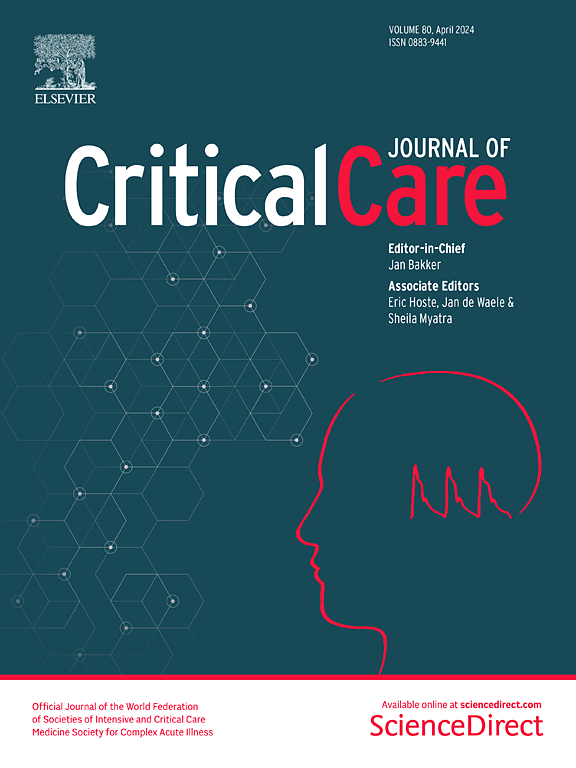揭示呼吸机相关肺炎的复杂性:对临床研究中使用的诊断标准和定义进行系统的方法学文献回顾
IF 8.8
1区 医学
Q1 CRITICAL CARE MEDICINE
引用次数: 0
摘要
呼吸机相关肺炎(VAP)是一种影响机械通气患者的普遍而严重的医院获得性感染。不同的诊断标准会使病情的识别和管理复杂化,从而严重影响 VAP 的研究,这也会影响临床管理。我们对 VAP 管理随机对照试验 (RCT) 中使用的诊断标准和 "呼吸机相关 "一词的定义进行了评估。根据协议(PROSPERO 2019 CRD42019147411),我们在 MEDLINE/PubMed 和 Cochrane CENTRAL 上对 2010 年至 2024 年间发表或注册的 RCT 进行了系统检索。我们纳入了对成人 VAP 患者进行药物或非药物干预评估的已完成和正在进行的 RCT。我们使用经 Cochrane 协作组织认可的测试提取表收集数据。经过交叉核对后,以叙述和表格的形式对数据进行汇总。通过文献检索共找到 7,173 条记录。在排除不符合资格标准的记录后,共纳入 119 项研究。51.2%的研究提供了诊断标准,52.1%的研究对 "呼吸机相关 "一词进行了定义。最常见的诊断标准包括肺部浸润(96.7%)、发热(86.9%)、低体温(49.1%)、痰液(70.5%)和缺氧(32.8%)。不同研究中使用了 38 种不同的标准组合。呼吸机相关 "一词有 9 种不同的定义。在提供的研究数据中,VAP 的诊断标准和定义存在明显差异。在未来的临床试验中继续努力统一 VAP 诊断标准对于提高护理质量、实现准确的流行病学评估以及指导有效的抗菌药物管理至关重要。本文章由计算机程序翻译,如有差异,请以英文原文为准。
Unravelling the complexity of ventilator-associated pneumonia: a systematic methodological literature review of diagnostic criteria and definitions used in clinical research
Ventilator-associated pneumonia (VAP) is a prevalent and grave hospital-acquired infection that affects mechanically ventilated patients. Diverse diagnostic criteria can significantly affect VAP research by complicating the identification and management of the condition, which may also impact clinical management. We conducted this review to assess the diagnostic criteria and the definitions of the term “ventilator-associated” used in randomised controlled trials (RCTs) of VAP management. Based on the protocol (PROSPERO 2019 CRD42019147411), we conducted a systematic search on MEDLINE/PubMed and Cochrane CENTRAL for RCTs, published or registered between 2010 and 2024. We included completed and ongoing RCTs that assessed pharmacological or non-pharmacological interventions in adults with VAP. Data were collected using a tested extraction sheet, as endorsed by the Cochrane Collaboration. After cross-checking, data were summarised in a narrative and tabular form. In total, 7,173 records were identified through the literature search. Following the exclusion of records that did not meet the eligibility criteria, 119 studies were included. Diagnostic criteria were provided in 51.2% of studies, and the term “ventilator-associated” was defined in 52.1% of studies. The most frequently included diagnostic criteria were pulmonary infiltrates (96.7%), fever (86.9%), hypothermia (49.1%), sputum (70.5%), and hypoxia (32.8%). The different criteria were used in 38 combinations across studies. The term “ventilator-associated” was defined in nine different ways. When provided, diagnostic criteria and definitions of VAP in RCTs display notable variability. Continuous efforts to harmonise VAP diagnostic criteria in future clinical trials are crucial to improve quality of care, enable accurate epidemiological assessments, and guide effective antimicrobial stewardship.
求助全文
通过发布文献求助,成功后即可免费获取论文全文。
去求助
来源期刊

Critical Care
医学-危重病医学
CiteScore
20.60
自引率
3.30%
发文量
348
审稿时长
1.5 months
期刊介绍:
Critical Care is an esteemed international medical journal that undergoes a rigorous peer-review process to maintain its high quality standards. Its primary objective is to enhance the healthcare services offered to critically ill patients. To achieve this, the journal focuses on gathering, exchanging, disseminating, and endorsing evidence-based information that is highly relevant to intensivists. By doing so, Critical Care seeks to provide a thorough and inclusive examination of the intensive care field.
 求助内容:
求助内容: 应助结果提醒方式:
应助结果提醒方式:


